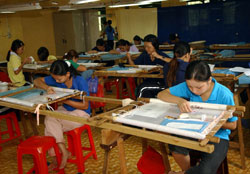
The treatment and rehabilitation of drug addicts as a means to prevent HIV/AIDS is expected to improve with the launch of a new project by the Ministry of Labour, Invalids and Social Affairs last week.
 |
| Trainees work at the embroidery workshop of the Phu Van Rehabilitation Centre in HCM City. |
The US$2.5 million project, funded by the US Centres for Disease Control and Prevention, would be implemented until September 2014 in HCM City and the northern province of Thai Nguyen, deputy head of the Social Evils Prevention Department (SEPD) Do Thi Ninh Xuan said.
Its objectives are to strengthen the ministry (MoLISA) 's capacity to treat and rehabilitate drug addicts through effective approach methods to reduce drug use, improve the quality of life, and reduce HIV infection among drug users and prostitutes.
The project is setting up a data collection and management system on drug addicts, prostitutes and addicted prostitutes, according to MoLISA.
The capacity of the ministry's staff to analyse and utilise data will be also improved.
Viet Nam has close to 150,000 registered addicts, a figure that has been growing by 6,000 a year since. All 63 cities and provinces have them.
Along with the increase, the demographics of drug addicts underwent remarkable change, MoLISA said. In the mid-1990s drug use was common among people living in the northern mountains.
Since the mid-2000s the number of addicts has been increasing rapidly in the Red River Delta and south-eastern regions.
The addicts have also been growing younger – in 2010 around 70 per cent were under 30 compared to 42 per cent in 1995.
More than 95 per cent of users in Viet Nam are men. But the number of women addicts has been increasing.
The method of use has also changed: in 1995 less than 8 per cent were injecting drugs while more than 88 per cent were smoking them; 14 years later three-fourths of addicts are intravenous users.
This has led to an alarming rise in HIV infection.
Figures from the Ministry of Health show that addicts using needles account for most of the people with HIV.
A recent MoLISA survey found that the majority of the drug addicts were poorly educated with more than half not going to high school and 10 per cent being illiterate, only 12 per cent getting vocational training.
With drug abuse rising, MoLISA said treatment of addicts and training to help them return to the community and integrate was essential.
It said it planned to review the rehabilitation system for investment in community-based treatment and improved management.
A number of models would be tried to treat some 500 addicts.
Each year 40,000-50,000 addicts are treated, or 25-30 per cent of the total registered number, including 30,000-35,000 at treatment centres. The rest are treated in their communities.
(Source: VNS)




